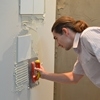craquelure itself refers to the crevices and cracks that form on the surface of the glaze. The pattern of these cracks is often circular, although they may be scattered across the surface of the glaze. As a rule, the cause of such defects is poor interaction between the coefficients of thermal expansion of the glaze and the ceramic body. Despite the fact that such cracks are very thin, they nevertheless interrupt the surface of the glaze, and, consequently, reduce the impermeability of the tile and worsen its external qualities. It should be remembered, however, that there are tiles for which cracks in the glaze surface are a deliberate aesthetic effect, imitating antique tiles.
The test method for determining the resistance to cracking of glazes (craquelure) of ceramic tiles and slabs is given in the EN ISO 10545-11:1996 , IDT standard. To determine the resistance to cracking of glazes, tiles and slabs are subjected to high pressure steam in an autoclave. Then the tiles and slabs, after applying the dye to the glazed surfaces, are examined for the presence of cracks in the glaze.
There is 1 Comment
Examples of glaze cracks
EN ISO 10545-11 provides pictures with examples of glaze cracks.
- Login to leave comments

